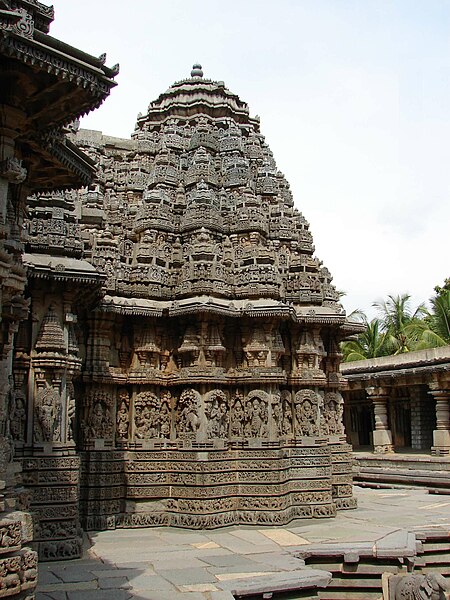Lakshminarasimha Temple, Javagal
The Lakshminarasimha temple at Javagal, sometimes referred to as Lakshmi Narasimha temple of Javagallu, is a mid-13th century Hindu temple with Hoysala architecture. It is located in Javagal about 20 km northeast from Halebidu and 50 km from Hassan city, Karnataka state, India. This triple shrine temple is dedicated to Narasimha – the man-lion avatar of Vishnu. It was completed between 1250–1260 A.D. by King Vira Someshwara of the Hoysala Empire.
Lakshminarasimha Temple, Javagal
The outer walls and shikara of the Lakshminarasimha temple at Javagal.
Lakshminarasimha temple at Javagal - north view
Front
Hoysala architecture is the building style in Hindu temple architecture developed under the rule of the Hoysala Empire between the 11th and 14th centuries, in the region known today as Karnataka, a state of India. Hoysala influence was at its peak in the 13th century, when it dominated the Southern Deccan Plateau region. Large and small temples built during this era remain as examples of the Hoysala architectural style, including the Chennakesava Temple at Belur, the Hoysaleswara Temple at Halebidu, and the Kesava Temple at Somanathapura. These three temples were accorded UNESCO world heritage site status in 2023. Other examples of Hoysala craftsmanship are the temples at Belavadi, Amruthapura, Hosaholalu, Mosale, Arasikere, Basaralu, Kikkeri and Nuggehalli. Study of the Hoysala architectural style has revealed a negligible Indo-Aryan influence while the impact of Southern Indian style is more distinct.
Profile of a Hoysala temple at Somanathapura
Vishnu with Lakshmi (Lakshminarayana) at Halebidu
Shiva, Parvati, Nandi at Halebidu
Hoysala stepped temple tank (Kalyani) at Hulikere, Karnataka








